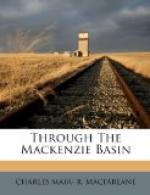Altogether we estimated the prairie areas of the upper river at about half a million acres, with much country, in addition, which resembles the Dauphin District in Manitoba, covered with willows and the like, which, if they can be pulled out by horse-power, as is done there, will not be very expensive to clear. There is, of course, any quantity of timber for building and fencing, though much has been destroyed by fire, the varieties being those common to the whole country. To the south, in the Yellowhead, and on the Upper Athabasca and its tributaries, there is considerable prairie also, more easily reached than Peace River; but this is apart from my subject. I may say, in conclusion, that the Upper Peace River country is a very fine one, drained by a vast and navigable river, compared with which the Saskatchewan must yield the palm, and, beyond doubt, this will be the first region to attract settlement and railway development.
Aside from settlers and a railway, the chief needs of the country are a good waggon-road to Edmonton and mail facilities, which were almost non-existent when we were there, but which have recently been to some extent supplied. Nearly three months had elapsed since we entered the country, and not a letter or paper had reached us from the outer world at any point. The imports into the country were increasing very fast, and, through competition and fashion, its principal furs were immensely more valuable than in the past.
As for the natives of the region, we found them a very worthy people, whose progress in the forms of civilized life, and to a certain extent in its elegances, was a constant surprise to us. As for the country, it was plain that all we met were making a good living in it, not by fur alone, but by successful farming, and that its settlement was but a question of time.
Chapter VII
Down The Peace River.
We had now to descend the river, and our first night in the boats was a bad one. A small but exceedingly diligent variety of mosquito attacked us unprepared; but no ordinary net could have kept them out, anyway. It was a case of heroic endurance, for Beelzebub reigned. The immediate bank of the river was now somewhat low in places, and along it ran a continuous wall, or layer, of sandstone of a uniform height. The stream was vast, with many islands in its course, and whole forests of burnt timber were passed before we reached Battle River, 170 miles down, and which, on the 25th, we left behind us towards evening. Next morning we reached Wolverine Point, a dismal hamlet of six or seven cabins, with a graveyard in their midst. The majority of the half-breeds of the locality had collected here, the others being out hunting. This is a good farming country. Eighteen miles north-west of Paddle River there is a prairie, we were told, of rich black soil, twenty-five miles long and from one to five miles wide, and another south-west of Wolverine, about nine miles in diameter and thirty-six in circumference—clean prairie and good soil, and covered with luxuriant grass and pea-vine. The latter, I think, is watered by a stream called “The Keg,” or “Keg of Rum.” Wolverine is also a region of heavy spruce timber, and fish are abundant in the various streams which join the Peace River, though not in the Peace itself.




